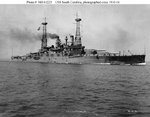BombTaxi
Tech Sergeant
A close look at the pic shows why the system didn't work - the turrets were fixed together so both sets of guns had to engage the same target. This was no use if there were torpedo boats closing in, and spotting fall of shot must have been a nightmare too...

